October 30, 2003
Just What You've Always Wanted in Online DVD Rentals
Netflix is the king of online DVD rentals.
But me, I rent with Greencine. And in the last couple of months, Greencine has announced two developments that makes it as good as, if not a better, service than Netflix.
First, they lowered their monthly rate to $19.95. So it now identically matches Netflix.
Second, they've introduced porn. Errr, I mean, "Adult." This is something that Netflix will never do, as CEO Reed Hastings involvement with California public schools pretty much precludes him from being a smut provider.
Both of these, in conjunction with the fact that Greencine stocks more indie, international, and just plain weirder titles, and that it gives a percentage of proceeds to SF Bay Area film organizations, AND it has a friendly and attentive customer service staff, well, it makes staying a Greencine member that much easier.
October 29, 2003
About With and For Part 4: Ethnography Roolz!
Caroline Barry from Portico Research loves loves loves doing ethnographic research. A vivacious woman, she shared her passion for talking to and observing people, and how such work has helped her help companies better understand their customers and their desires.
Her company is quite impressive. It's chock full of social scientists (ethnographers, social psychologists) and even has a couple of documentary filmmakers. Not surprisingly, it turns out doc filmmakers are amazing video ethnographers (though it *is* surprising how rarely people employ doc filmmakers for such things. the doc filmmakers i know have amazing skills and work cheap.).
Essential for Caroline in her work is to find the magic, the thing that catalyzes inspiration from observations. I've never seen someone in the design profession be so comfortable with treading in emotional waters. In her presentation, she showed a series of video clips from her research, that ranged from unbridled joy, to dreadful sadness. Willingness to show true human feeling is remarkably powerful.
One of Caroline's case studies was a research project around Taco Night. Do you know about the Taco Night phenomenon? I didn't. It's an event Caroline has been wanting to study forever.
Taco Night is the family culinary event where, once a week, you make tacos. You have all the ingredients at the table, and assemble your desire. It turns out that Taco Night is fundamentally different from every other dinner night.
For dinners where it's just a meat-n-three, Portico saw that families often didn't get together. The kids didn't want to leave their video game conoles. The dad wouldn't get home from work on time. The mom would be frustrated that no one is cooperating.
Taco night, on the other hand, was a beloved event. Kids couldn't get enough. Dad's always made it home. Mom and dad would go a little wild, drinking margaritas. The magic that Caroline saw was captured in a statement that one of the kids said during the observation, "On taco night, we make mom laugh."
Caroline's talk resonated with something I realized at the DUX2003 conference, that designer/user experience people/whathaveyou can have a significant impact through our ability to communication emotion in our work. I tend to be quite dry, clinical and analytical, in my client work, and such presentations remind me that it's not only okay to go for the gut -- it's preferable.
October 28, 2003
About With and For Part 3: Students Say The Darnedest Things!
Being a student-run conference, it makes sense there would be student presentations.
The first student presentation I heard was Michael Winnick's "Crossing the Other Chasm: The perils of getting concepts into development". He opened with Geoffrey Moore's take on the technology adoption life cycle, where a chasm exists between early adopters and getting the product into the mainstream -- it's at this point that many products fail in the market. Michael turned the chasm focus inward...
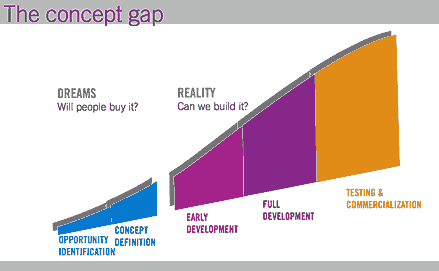
His basic thesis is that if we can successfully cross the product development chasm, we can be more confident that we will cross the technology adoption chasm. He identifies the crux of the problem as a gap between the marketers and the engineers, where the marketers develop a requirements document full of features and great ideas, but the engineers need to develop a specification that precisely labels how the thing will work, and the two are never well reconciled. Marketers need to get more concrete, and engineers more abstract, so they can meet up in the middle and ensure that ideas flow successfully.
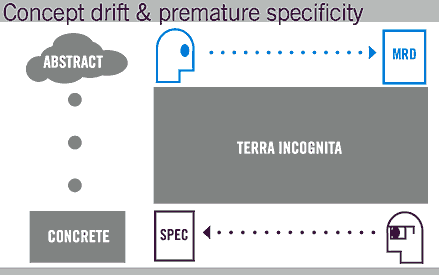
Michael works at Gravity Tank, an impressive product research and design firm, and listed 7 steps that they've found helpful in navigating these murky waters:
1. Accept change
2. Reduce barriers to actual users
3. Get everybody together
4. Prototype in low fidelity
5. Embody research, don’t report it
6. Make decisions explicitly
7. Validate embodied concepts
The first two are obvious. The third is about getting all members of the team, be they engineers, marketers, business owners, designers, whoever, in the room together, collaborating. The fourth addresses how they can collaborate -- give everyone simple tools for prototyping solutions -- tap the latent creativity in folks whose lives are mired in Outlook and PowerPoint.
The fifth point resonates with the work we do at Adaptive Path. About the least useful deliverable is the Lengthy Report that Sits On A Shelf. To the degree possible, put your research in action -- it will ensure adoption by the developers.
The second student presentation I saw was Dale Wunderlich's "Teams At Work." [2.3 MB PDF]. He and his team of students researched the dynamics of meetings, utilizing Edward De Bono's "Six Thinking Hats" model to develop a color spectrum of participation.

(This graphic is here to tantalize you into downloading the presentation.)
It's a really impressive piece of work. The team minutely analyzed meetings in order to understand how people "enter" and "exit" the stage, the nature of their contributions, and the effect of the environment. They did so for descriptive, not prescriptive, purposes, though it wouldn't take much to imagine how this understanding could help guide meetings towards greater productivity.
I just want to add that not only in this presentation, but in all my interactions with ID students, I was very impressed by their skill, savvy, wherewithal, groundedness, rigor, and humility.
[Side note to ID students: Did you know about the Secret Lives of Michael and Dale? It turns out that Michael Winnick is also a CPA, and that Dale Wunderlich has run for office in Alaska.]
October 26, 2003
About With and For Part 2: Vijay's Talk
The meat of the conference were eight presentations given by various design professionals. Unfortunately, there were only two time slots, which means four talks took place concurrently. Choosing was not easy.
The first session I went to was lead by Vijay Kumar, a professor at ID. I went because all of the ID students I met love him. They say he's a great, fun, smart, friendly teacher. From what I saw, I concur.
The other thing to know about Vijay is that he resides in a world of frameworks. He loves models. It seems he has not met a matrix he didn't like.
His talk, Insights to Innovations (not yet online), addressed the steps designers take to get from insights derived from research, to concepts that drive new product ideas. Vijay has a delightfully simple two-by-two that represents the steps in a design process:
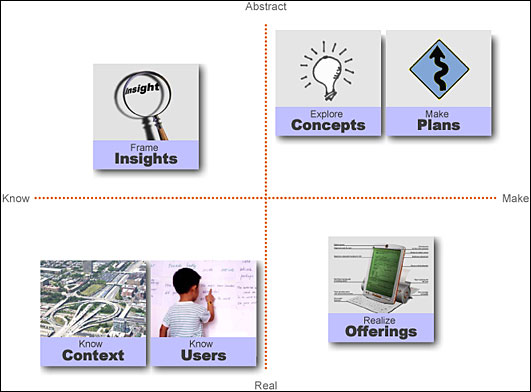
You start in the lower left-hand corner, getting to "know" the "real" - users and their contexts. Then you move up, abstracting from that knowledge to frame insights. Then you progress from knowing to making abstractions -- concepts and plans. And then you end up by producing something tangible. In a more standard framework, the quadrants would read, clockwise from lower left, Research, Analysis, Synthesis, and Implement.
I don't know how useful this framework is, but I'm a fan of it. A smart encapsulation of what we go through.
The bulk of Vijay's talk was about how we cross the threshold from insights to concepts. From analysis to synthesis. He claimed there are four modes for bridging this gap:
Criteria can be thought of simple noun phrases that emerge from an insight process. The classic example of this (and one which you'll hear ad nauseum if you spend any time at ID), are Oxo Good Grips. You can think of the Good Grips line as a series of physical properties -- large handles, rubber handles, ovoid shape (so they don't rotate in your hand), large clear type, etc. etc.-- that support ease of use for people with motor or perceptual challenges.
Principles are verb phrases that address are like sentences in a mission statement for the product. The example used came from a student project for a museum (the Museum of Science and Industry, I believe). From the research, the museum developed a set of principles: 1) Provide real and tailored visitor experiences, 2) Extend access to the museum experiences, 3) Foster a culture of innovation.
Frameworks are a bit more complex. They tend to be grids, matrices, any kind of system that identifies key attributes and highlights opportunities. One framework currently under development at ID is the Concept Matrix:
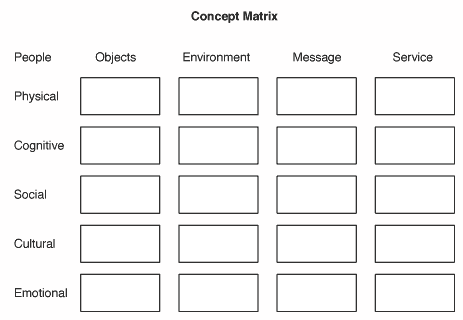
The Concept Matrix is known for it's POEMS mnemonic across the top. Down the left side are five factors of people. The matrix can be helpful to companies identify opportunities...
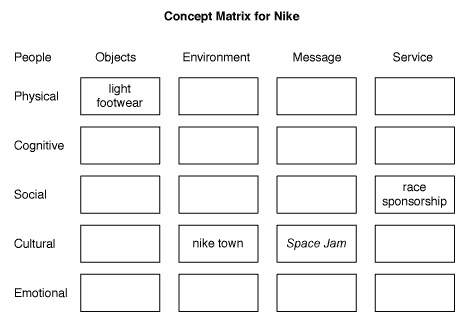
(Vijay had more stuff in boxes, but I didn't get it all down... I'm still not quite sure I buy the Concept Matrix...)
The last are scenarios, which might be the most basic. What stories can we tell, based on what we know about users and their contexts, that suggest ways of addressing their needs and desires? What are people's key factors and driving forces? What makes sense in terms of supporting those factors and forces? (I love the idea of writing as design method, and I just need to remember to do it more often.)
What I liked about Vijay's talk is it presented a series of ideas in a cogent fashion that allows someone like me to see "where I fit", and to consider, "Where could I go? What am I not taking advantage of?"
(Side thought on AIGA's Power of Design)
So, I'm reading these notes from various illustrious speakers, and all I can think is, "I'm sorry... Isn't this the same circle jerk the "design profession" has been engaged in for the past... 5, 10, 20 years?" "The Power of Design." "Design is All Around Us." "Design as Social Responsibility." etc. etc.
Okay. So I decided to strike-through that. It was a bit harsh, a toss-off based on initial thoughts. Not that I don't stand by it. But perhaps it's worth digging a little deeper.
I suppose my main problem is how the notes from presentations at The Power of Design seem to have come from the self-help section in a bookstore. Either it's the "Design is Everywhere" stuff, detailing just how essential design is in our lives, or it's the "Design Can Save the World" stuff, all about sustainability, and developing countries, and smart use of resources, or it's the "Design Is Not Doing Enough", a set of chastisements about how designers aren't living up to their potential in a world that needs them.
I suppose it would be less irritating if these were novel ideas -- but they seem to be the subject year in and year out. The profession of design can't help but discuss how glorious and essential it is, while bemoaning its underappreciation and underachievements.
I love working with designers -- they see the world in ways I don't. I just can't bear this incessant Big Picture Hand Wringing, which inevitably keeps me at arm's length from the "design profession." (And causes me to wonder if the AIGA are the appropriate stewards for Big D-Design.)
About With and For Part 1: A Great Conference
The IIT ID's About, With, and For conference was my second favorite conference experience this year, after the IA Summit.
The success of the conference was largely due to the focus of the topic -- methods for synthesizing user research to provide insights and concepts that lead to better product design. The specificity meant a deep look at what is perhaps *the* essential step in the user-centered design process. No matter how expert you were, you couldn't help but learn something new.
I missed the pre-conference workshops (I had to make my pilgrimage to Quimby's), but heard they went brilliantly. 6 different workshops took place simultaneously, each offering a different approach to synthesizing user research. In conversation afterward, Steve Portigal captured the experience as such, "It was like one of those comedy movies or television shows where you open the door and something that you didn't expect is happening. About half way in to the workshops, I visited each of them, and in one room you had people analyzing 30 sec videos, in another was a whiteboard session you'd expect at a consultancy, another featured arts-and-crafts with scissors and paper, in yet another a room was silent as people were writing their thoughts..." If nothing else it showed the remarkable range of approaches to making sense of what we observe.
The conference itself was a single day. I had the fortune of kicking it off with my talk, "Then a Miracle Occurs...", which I presaged in a prior peterme post, and which I'll write up more completely at some point in the future. The title comes from the following Sidney Harris cartoon:

Which for me, captures this notion that we get user data, and through some mechanations, produce something that directly informs the design. How do we do that?
[Note: I *just* now discovered that my business partner Jesse James Garrett uses the same cartoon to illustrate a similar, but different, point in his rumination on the practice of information architecture.]
A later presentation by Michael Winnick, a student at ID, labelled a similar mystery in the product design process. How we get from business requirements (often captured in a marketing requirements document) to a spec. He labelled the void in between as "Terra Incognita," which made me think of unchartered waters. If I give my keynote talk again, maybe instead of the cartoon, I'll do up some cartography with "here be dragons."

October 25, 2003
Urban Bookstore Pligrimages
I realized, on this last trip, that when I travel, I inevitably end up at the certain favorite bookstores.
In Cambridge, I make a point of visiting the MIT Press Book Store, and Wordsworth.
In Chicago, I've got to go to Quimby's. And the Seminary Co-op might prove necessary on future itineraries. (Thanks, Betsy!)
New York City? Gotham Book Mart. (Looks like they might be moving.)
Washington, D.C.? Kramerbooks and Afterwords cafe.
In Portland, well, it's just too obvious.
Huh. The other cities I often return to are Austin and L.A. And while I like The Book People in Austin, it's never been very compelling (unlike, say, sitting outside at Jo's.)
October 23, 2003
HITS Parting Thought: Innovation Fetishization
The HITS 2003 conference was very focused on the idea of innovation. Whenever designers talk about business, they can't get away from the need to "innovate." It seems to be what designers think they can best offer business.
Such an obsession with "innovation" worries me. It worries me because I live in a world where the things that already exist typically don't work as well as they should. More time should be spent bringing existing products and services up to snuff, and not focusing on The Next Big Thing. This innovation fetishization becomes a shiny bauble distracting people from paying attention to the here and now.
I also find that most of us don't get to work on "innovation." We'd love to, but it's not practical. Maybe it's just me, but the bulk of my work is to get corporations to stop fucking up how they do things, or, at least, to fuck up as little as possible. Conferences like HITS make me nervous because I fear that folks (particularly students, who were very much in attendance) think that life is about innovation, and then will be needlessly disappointed when they enter the real world and find out that the bulk of their time is spent shoring up poorly planned solutions.
Not that I'm against innovation. There's a place for innovation. I wish my work afforded me more ability to innovate. But we've got to be careful to not forsake the now in favor of planning for some distant future.
Oh, and most of the presentations from HITS are up. I've gone back to my old posts and updated them with links, where appropraite.
October 22, 2003
Highlights from HITS Part 3: Summary Thoughts
The prior two posts weren't the only things that happened at HITS. Don Norman exhibited remarkable contradiction by railing against BusinessWeek's annual design awards for focusing on the external aesthetics and not about deep use, only to then talk about how an object's beauty can create an emotional resonance that makes the fact that people can't figure out how to use it moot. There were a few case studies of design processes leading to business success, most of which seemed like a way that ID can crow about how its grads are doing great work out in the world. Larry Keeley of the Doblin Group charmed the crowd with his Big Idea talk on innovation[5.1MB PDF], presented like a true showman. (It's also clear Larry is super smart. For those playing along at home, many moons ago I posted about the Doblin Group (scroll down to September 16, 1999))
Overall, I found HITS 2003 a worthwhile experience. (Literally--I think it's the only conference I paid for out of my pocket all year.) There was a curious aspect to it. It's an inaugural conference. I've been to two other inaugural conferences in recent memory (ASIS' IA Summit in 2000, DUX in 2003), and both of those were very much a coming together of a community, bringing into a single place individuals who had felt a little lost or uncertain of their professional stature, making it clear that there is a place for them.
That did not happen with HITS. There is no identifiable "design + business" community. I think because the problem is too big, too diffuse. Design and business intersect at so many points -- how people interact in an organization, the value that design adds to products and services, the use of design methods to inform anything from high-level strategy to specific object, brand, etc. etc. -- that it can never be the nexus of a clearly defined community. I mean, I'm definitely interested in where design and business meet, but I didn't feel like I was among "my people" at HITS. Again, not that I didn't enjoy it -- it's just didn't feel transformative the way those other two events did.
October 21, 2003
Highlights from HITS Part 2: Experience Economics
IDEO's CEO Tim Brown spoke a bit about experience economics. He showed a lot of shiny pictures from their work on the Prada store, but I was more interested in two frameworks he discussed. The first is a pyramid that comes from the book "The Experience Economy" (I don't know if the 'birthday party' example is from there, too, or was Tim's example).
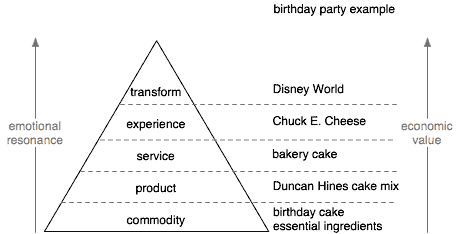
The second interesting idea is that in order for an experience to have an economics, it must fit these three criteria:
- the customer knows they had an experience
- the provider owns that experience
- the customer can tell others about that experience
Later on, in an unrelated panel discussion, ID professor John Heskett mentioned that the key core element that design brings to the business equation is "value creation." Of all the things the businesses desire in their processes, what design can most obviously and directly influence is the creation of "value" to be added to the product or service. I've heard this argument before, usually related to Michael Porter's "value chain."
Highlights from HITS Part 1: MBA 101 and Design
[There will be 3 highlights posts]
Last week I attended the inaugural HITS (Humans Interaction Technology Strategy) conference, sponsored by IIT's Institute of Design. An attempt to bridge the worlds of Design and Business, it offered a lot of food for thought. There was no ability for real-time blogging (the conference took place in a remarkably unwired venue), so here are some notes after the fact.
On the first day, we were treated to a couple of cold water presentations, one by Tom MacTavish from Motorola, and another by Jim Euchner from Pitney Bowes. I call them "cold water" because their diehard business perspective was an awakening splash in the face. Also, both utilized the ugliest PowerPoint templates you'll ever seen in a conference sponsored by a design school.
Tom's talk was a no-nonsense look at understanding business and technology[244k PDF], with clues as to how to get the most out of your organization, and how to read financial statements.
Jim's talk was more about the reorganization of teams in order to better encourage product design that succeeds. Jim had two four-circle Venn diagrams that I liked.
The first diagram was of the human elements that go into product design. Ideally, you have them all converge to produce the best work:
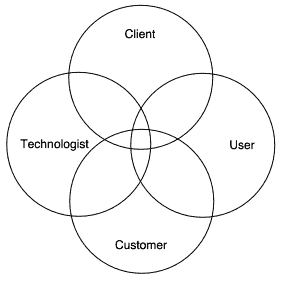
("Technologist" can be thought of as the engineer/designer, client is the internal business owner, customer is the person who buys the technology, and user is the person who will use it. Oftentimes in enterprises, the customer and the user are different people.)
He pointed out, though, that the reality is that the rings don't overlap, but get pulled to form a chain...
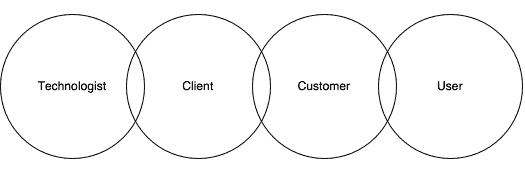
The client and customer serve as intermediaries in a chain between the technologist and the user. Such an arrangement hampers success, as it resembles the child's game "Telephone," where the fidelity of the message degrades as it passes from person to person.
I loved the idea of pulling the rings from that idealized Venn diagram to form a truer representation of how these things really work.
Another diagram of his also had four rings:
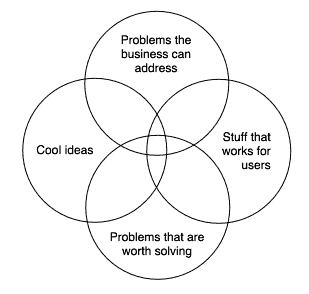
I liked this because it intelligently extends the more typical Venn diagram of feasibility/viability/desirability. It shows that feasibility has two aspects: 1) What we have the technology to build ("Cool ideas") and 2) What the business is geared to address. It's not enough to simply address a "problem worth solving" -- you also must consider whether your organization has the resources to meaningfully address that problem.
One of the things not mentioned in these first two presentations is ROI. Metrics. Finances. So I raised my hands and asked Tom and Jim about how do we consider the ROI of the design component (as we're increasingly asked to do these days) and both pointed out that the various parts of the process are so tightly integrated that awarding elements of the ROI to any particular contributor is nearly impossible. (I don't know if I agree, but I was intrigued that this was the response.)
In all, I was happy to see elemental business questions being addressed so straightforwardly as a way to lead off the day.
October 19, 2003
Chicago's Hottest Hot Spots!
I've spent the last few days in Chicago. It's 10pm on a Sunday, and I'm currently in a Starbucks on North and Wells -- and it's *packed*. All students. Lotsa laptops. Lotsa highliters. It's crazy busy. It's the first 24-hour Starbucks I've ever seen. Anyway. Carry on.
Novel Science
In my last post, I mentioned Radiant Cool, a novel that also happens to put forth a new theory of consciousness. Today, The New York Times Book Review features it and some other attempts at novel explanations of science.
October 13, 2003
What is that line about "So Many Books..."?
One of the best things about speaking at the UI Conference is that the event hotel is across the street from the MIT Press Bookstore. I pretty much never buy books new, but it's an amazing place to browse. While there, I added a few things to the ol' wish list:
 Radiant Cool, Dan Lloyd.The author presents a theory of consciousness -- in the guise of a detective novel. Sure it's a gimmick, but it seems pretty damned cool.
Radiant Cool, Dan Lloyd.The author presents a theory of consciousness -- in the guise of a detective novel. Sure it's a gimmick, but it seems pretty damned cool.
 Rules of Play, Katie Salen and Eric Zimmerman. Breaking down the DNA of what makes games games. A thick, well-designed book, chock full of, well, everything about game design. (It doesn't cost $49.99 for nothing!) I'm familiar with Eric Zimmerman's work and writing (he founded GameLab.) Katie Salen is new to me.
Rules of Play, Katie Salen and Eric Zimmerman. Breaking down the DNA of what makes games games. A thick, well-designed book, chock full of, well, everything about game design. (It doesn't cost $49.99 for nothing!) I'm familiar with Eric Zimmerman's work and writing (he founded GameLab.) Katie Salen is new to me.
Eric and Katie will be talking about their work in 11 days in NYC.
 Small Things Considered, Henry Petroski. Goddamn Professor Petroski. He keeps writing books on fascinating topics. Yet I've never found his prose very engaging. So while I always learn interesting stuff, it's always a bit of a slog to get through his material. With his latest, he dissects design in everyday life, and why no designed thing is ever perfect.
Small Things Considered, Henry Petroski. Goddamn Professor Petroski. He keeps writing books on fascinating topics. Yet I've never found his prose very engaging. So while I always learn interesting stuff, it's always a bit of a slog to get through his material. With his latest, he dissects design in everyday life, and why no designed thing is ever perfect.
October 11, 2003
peterme on the road
I see by my map that I'll be on the road next week, spending Sunday-Thursday in Cambridge, MA, and Thursday-Monday in Chicago, IL.
October 08, 2003
Two (well, three) Books Worth Reading (That You've Probably Already Gotten To)

 MONEYBALL, by Michael Lewis. Fellow Berkeleyan Lewis goes inside the front office of the Amazin' A's, a team with a pittance to spend on players that somehow manages to make it to the playoffs year after year (during which, they make asses of themselves by losing series after having been up 2 games to 0.) This is a tale with many lessons, most of them dealing with the foolishness of conventional wisdom and how hard it can be for people to see the truth that is dangling right in front of their very eyes. Some understanding and appreciation of baseball helps.
MONEYBALL, by Michael Lewis. Fellow Berkeleyan Lewis goes inside the front office of the Amazin' A's, a team with a pittance to spend on players that somehow manages to make it to the playoffs year after year (during which, they make asses of themselves by losing series after having been up 2 games to 0.) This is a tale with many lessons, most of them dealing with the foolishness of conventional wisdom and how hard it can be for people to see the truth that is dangling right in front of their very eyes. Some understanding and appreciation of baseball helps.
Baseball fans who have not yet read BALL FOUR, Jim Bouton's uproarious 1970 memoir about pitching in the big leagues. Controversial because it threw light on the seamy underbelly of "America's Pastime." Funny because, well, it's funny.
Both MONEYBALL and BALL FOUR expose a certain religiosity appiled to the sport of rounders. People's relationship with the game seems to be one of faith. MONEYBALL shows how baseball people act a certain way, because, well, they've always done things that way. And when someone (like Paul DePodesta, the A's Assistant GM) questions it, they're treated like a heretic. BALL FOUR demonstrated that baseball's saints (Mickey Mantle, Ted Williams) were people, just like anyone else -- a truth that many of the devoted simply didn't want to hear.
October 04, 2003
More thoughts on Urban Tribes
A post to the Many to Many weblog about how Friendster relies on Urban Tribes got me thinking. I tried posting this as a comment there, but there was an error. So I'm posting it here:
======
As the author of the scathing review, I feel it's worth mentioning that I agree with danah that Friendster's bread-and-butter are those who belong to "urban tribes." Actually, the Friendster/Urban Tribes cross is a potentially rich field for exploration of this emerging social group. I'm thinking of a sociological/anthropological discussion of how social software mediates and extends the interactions of these folks. Is it coincidence that Urban Tribes emerged as a force at around the same time as the internet took off? How has email, IM, and now systems like Friendster promoted the development of Urban Tribes?
October 02, 2003
Understood Loud and Clear
Last night I went to see LOST IN TRANSLATION. It's nearly as good as everyone says. It's a thoughtfully-paced character study that, remarkably, never bores. It helps to have Bill Murray -- film cameras love Bill Murray, and Bill Murray loves film cameras. And while he's been earning deserved accolades, his performance isn't really all that surprising -- he's done just as well in films like GROUNDHOG DAY or RUSHMORE.
Scarlet Johannson, on the other hand, shines brightly in a way we've not seen her before. Folks will be familiar with her good work in GHOST WORLD and THE MAN WHO WASN'T THERE. But she was always a supporting character. In this film, she does work worthy of a Best Actress nod. (Not that she'll get it. The Academy doesn't take young actors seriously for such honors.) Charlotte (Scarlet's character) is the emotional heart of the film. If Scarlet's performance doesn't pan out, the film simply wouldn't work, and no amount of Bill Murray's mugging could save it. But Scarlet maintains her intensity, her hold on you (and on Bob), letting you believe everything you see on the screen.
For those who've seen the movie, I'm including more commentary in the extended entry of this post....
One thing that no critic has mentioned is that Bill Murray's character is essentially impotent. He might be a rich and famous movie star, but his life is driven by others, all women -- his wife choosing carpet colors, Charlotte buying him a drink and inviting him to hang out with friends, the call girl demanding he "lip my stocking," the women who lead him around as he does his work duties, the singer who picks him up at the bar.
Charlotte is dynamic, and the heart of the film, because she does her own thing. While Bob is being poked, prodded, tucked, and directed, Charlotte's learning ikebana, or visiting temples. Charlotte has the nerve to buy him a drink, the idea to drag him out to hang out with friends.
[SPOILER]
It makes the end of the movie all the more poignant. It's not just Bob getting out of a taxi to say one last goodbye. It's Bob, for the first time in the entire film, acting on his own impulses, exerting his own free will, breaking free of the leash he'd been letting himself be lead by.
Other though:
Critics have been giving Giovanni Ribisi's character an unfair rap. He is most definitely *not* the problem in their relationship. He's dopey, sure, and work-obsessed. But he clearly loves Charlotte. Charlotte's malaise has far less to do with him than with herself.
